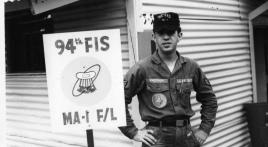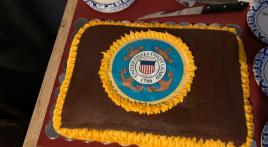Dedicated to my late uncle, Dr. Hirsh M. Busch, who just recently passed away, and to his dear friend, the late Waldron Polgreen, and to all the young men who perished that day, Christmas Eve 1944.
Author's Note: In late December 1944, troops from three U.S. Army regiments of the 66th Infantry Division - the 262nd, 263rd and the 264th - gathered to board a troop transport bound for the European continent.
On Christmas Eve, Dec. 24, 1944, the SS Leopoldville (originally a merchant ship later converted for military transport) ferried more than 2,000 American replacements to join the fighting in what became known as the Battle of the Bulge. Escorted by six of His Majesty's warships, it set sail across the English Channel from Southampton, England, to Cherbourg, France.
Aboard the Leopoldville, 2235 very young American soldiers - some just 18, including this writer's uncle Hirsh M. Busch - did their best to find even the tiniest bit of comfort aboard a ship that was grossly overcrowded, lacking direction from a trained shipboard crew, and in possession of insufficient stores of edible rations and potable water.
Before the ship set sail, what should have been a precise and orderly boarding process descended into chaos. Human error, compounded by several delays from the War Department, worsened an already bad situation. Officers became detached from their units. Hundreds of enlisted men began boarding by themselves at the wrong time and place.
Even before it set sail, the Leopoldville was an organizational nightmare.
"I was sick as a dog from seasickness 'down in the hole' where I finally settled in, if you can call it that," Uncle Hirsh later recalled in an interview.
Worse however than even the 'epidemic' seasickness was the fear of the unknown and unseen. Christmas Eve it may have been, but there was no cessation of hostilities.
When the Leopoldville was no more than five miles off the French coast, "I was still down in the hole when we were hit by a torpedo from U-486, a German submarine."
Pandemonium broke out as hundreds of men raced to reach the upper deck. Hundreds died trying. Many troops perished upon the torpedo's impact. Thousands of gallons of seawater came rushing through the hole left by the torpedo. The ship began to sink.
"You can't believe the chaos that ensued. Many men jumped to their deaths wearing their full battle gear, snapping their necks in the process because they had not undone their helmet chinstraps. I threw off my entire pack before I started down the ropes."
Others died crushed between the two ships while attempting to leap from the deck of the Leopoldville onto that of the HMS Brilliant, whose captain undertook a difficult maneuver, trying to bring his ship parallel to and alongside the Leopoldville.
"You can't imagine it without having been there. I lost my best friend that day, a man twice my age. 36-year-old Waldron Polgreen, a married man and father of three young boys, could have stayed home, but he understood that his country's freedom was in peril."
My Uncle Hirsh survived that day, rescued by French coast guard vessels and subsequently shipped back to England where he fully recovered. The remains of PFC Polgreen washed up on shore and, along with those of 762 other American men, were buried in what became known as the Normandy American Cemetery and Memorial.
The story of the Leopoldville's calamitous voyage remained unreported for decades after the end of the war in Europe for reasons beyond the scope of this essay.
Christmas Eve 1944, 72 years ago
Skokie, IL
January 20, 2017
Submitted by:
Alan D. Busch



